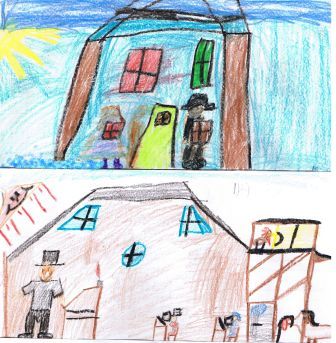
Pointing to a page from an old schoolbook, Mr. Carothers asks students to imagine they are in an 1818 classroom. Schoolbooks were very different — just loose
 pieces of paper. You learned by taking notes. But not in a notebook! You used chalk to copy down lessons on a piece of slate. For homework, you would take the slate home to copy the lesson down again with pen and ink onto a sheet of paper.
pieces of paper. You learned by taking notes. But not in a notebook! You used chalk to copy down lessons on a piece of slate. For homework, you would take the slate home to copy the lesson down again with pen and ink onto a sheet of paper.Children had two sets of clothes. You wore one outfit every day of the week, and changed into your good clothes on Saturday for services. Your mom then washed your everyday clothes for you to wear again next week. Two new volunteers struggle into reproduction period clothing. A full-length gingham dress over a blouse with bonnet, and drop-front britches with suspenders over shirt are paraded down the center of the auditorium. How are his clothes different? Yes! He does have suspenders. No, he has no belt
 loops. No pockets in the back either. His mother made all his clothes for him, spinning the wool from flax first. Pockets would have been too expensive, a waste of cloth. And, no, no zippers — they weren’t invented yet — so just buttons, hooks and straps.
loops. No pockets in the back either. His mother made all his clothes for him, spinning the wool from flax first. Pockets would have been too expensive, a waste of cloth. And, no, no zippers — they weren’t invented yet — so just buttons, hooks and straps.You had the same basic things inside your tin lunchbox as you might today, but they looked different. What is this spoon made out of… wood? bone? It’s a cow horn spoon! (you couldn’t afford metal) for your stew, porridge, or maybe soup. You had an apple — isn’t this one weird looking? Because it’s old? No, because I picked it from a heritage tree outside the museum, the same kind they had in 1818. And you had a piece of old crusty bread … and that’s about it!

 are you from schoolchildren 200 years ago?
are you from schoolchildren 200 years ago?Here is one account by a 2nd grader at Peace Dale Elementary School:
In the 1800’s I learned about the people. They did not have any TV’s. They didn’t have TV’s because they didn’t have power. They made spoons out of cow horns. They saved the cow horns for spoons. A man wrote a paragraph in cursive, one was his math and one was notes. He wrote by himself.
 In the 1818’s the girls wore bonnets. Bonnets are hats that keep away the sun, but now we use them for showers. And in 1818 they used a tin lunchbox and for their lunch, they got an apple, a piece of bread, and water and a spoon. The spoon was for the water. They cut the apple in half. They put it on the bread. They rang a bell. The bell was gold it was very loud. My ears popped like a fire engine, like the horn on a truck going wild, or the giant gold bell ringing, “a-ling a-ling!” They could ride in a carriage or walk; they can ride on a horse because the horse pulls the wagon. You can
In the 1818’s the girls wore bonnets. Bonnets are hats that keep away the sun, but now we use them for showers. And in 1818 they used a tin lunchbox and for their lunch, they got an apple, a piece of bread, and water and a spoon. The spoon was for the water. They cut the apple in half. They put it on the bread. They rang a bell. The bell was gold it was very loud. My ears popped like a fire engine, like the horn on a truck going wild, or the giant gold bell ringing, “a-ling a-ling!” They could ride in a carriage or walk; they can ride on a horse because the horse pulls the wagon. You can  walk because it does the world a favor. It keeps the world alive.”
walk because it does the world a favor. It keeps the world alive.”



No comments:
Post a Comment